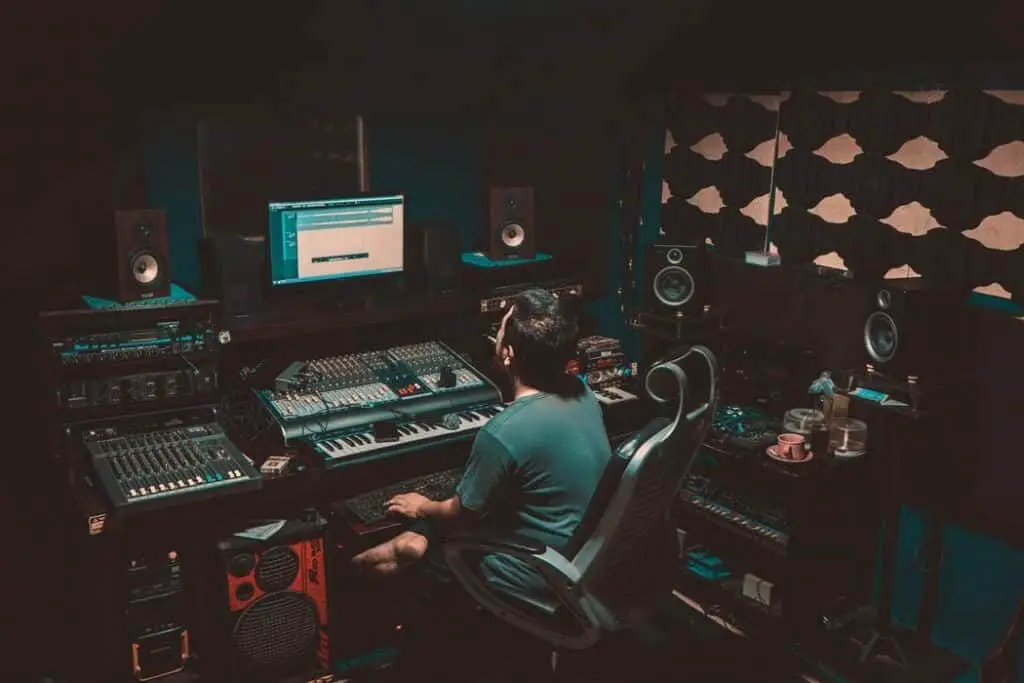
As a beginner, you built a small bedroom studio, and it served you well to an extent that you had to expound and eventually build a slightly bigger audio studio in your house and now you want to go all out and create a pro studio where you can have clients and two sound engineers as your employees. You are looking forward to setting up a pro or semi-pro studio. You don’t have to look further to know what your pro studio will need and some equipment that will set you out on the great journey that you are looking to start.
We will look at the equipment that you should have in your semi-pro and pro studio. Below is the equipment that you need.
- Studio rack mounts.
- Power Conditioner
- Microphone Preamp.
- Headphone Amp.
- Monitor Management
- Virtual Instruments.
- MIDI Controller.
- Electronic Drum Kit.
- Control Surface.
- Software/Plugins.
- Snake Cable
- Uninterruptible Power Supply.
- Direct Box
Now let’s look at each one in more detail…
1. Studio Rack Mounts.
Since you are moving into a bigger space and your intention is to work with more people and create a business out of your studio, you need to get studio rack mounts. These will help you mount more equipment and avoid clutter. As you might have noticed in a dedicated home studio, you opted for a single workstation because your space was smaller and you just needed a set up for a single machine. For a much bigger studio, get studio rack mounts.

2. Power Conditioner.
Have you ever gone to a studio and noticed how they have their cables set up so carelessly? That is exactly what you want to avoid when you invest in a power conditioner. The power conditioner will help you set up your power cables in a neater and safe way and also help in merging power for the entire rack down a single cable. It also filters the power using various technologies such as surge protection, voltage regulation and noise filtration which extends the life of your gear and allows it to always perform at its best. Investing in power conditioners is very important.

3. Microphone Preamp
When you have everything concerning the power and its set up out of the way, take your concentration to other extra input channels like microphone preamp. You will have access to this by adding a multi-channel microphone preamp to your setup. Another common variety of this device is the high-end single-channel mic preamp, which studios often use on vocals or any other particularly important track in a mix. You should also make sure that whenever you buy a microphone, preamps make sure that your audio interface has enough line inputs to accommodate the extra channels.

4. Headphone Amp
The good thing about investing in a pro studio is that everything you end up investing in will always be useful. After including many inputs, you can now invest in other output channels like headphone amps. This is very important for someone who is making their studio business. More headphone amps will ensure that if you have many clients at a time, they can use the headphones to monitor their performance during recording. Since most audio interfaces have only 1-2 headphone outputs… you’ll need a headphone amp if you want more. Common headphone amps offer stereo outs for anywhere from 4 to 8 sets of headphones.

5. Monitor Management.
Since you have dealt with the output channel options for your headphones, and they are in plenty, get extra outputs for multiple studio monitors. The reason monitor management outputs are important is so that your sound engineers can compare their sound mixes over a variety of playback devices. They do this just to make sure that the quality of their work is good, regardless of which kind of speaker is being used. For them to accomplish all this, they need the monitor management equipment.
6. Virtual Instruments.
A Virtual instrument is some software that allows you to have access to inbuilt instruments that would come in handy for you if you are the only one doing the recordings. When there is a need to play a part that includes multi-instruments, the virtual instruments will really come in handy for you. If you don’t invest in this software, then you need to be semi-proficient in all these instruments, if not proficient. Be sure to invest in virtual instrument software to avoid such hassles.
7. MIDI Controller.
When you are working with virtual instruments, you don’t get the original feel of working with normal instruments. It gets boring for sound engineers, and that is where MIDI controllers come in. While they aren’t perfect, they allow for at least some expression by giving you something real to touch with your hands. They make the experience more realistic and more fun. Who doesn’t want to enjoy the work they do? The answer will be no one, so invest in MIDI controllers to help you with your virtual instruments.

8. Electronic Drum Kit
You might wonder, well I already invested in virtual instruments which will also have a section for virtual instrument drums, but they really don’t come through like how electronic drum kits would and that is a reality because dramas don’t enjoy using the virtual form of the drums. This is because electronic drum kits provide an excellent compromise between the “real” and the “virtual“.

9. Control Surface.
Working from home in a home studio can get really frustrating because you might have all the important equipment that will allow you to work, and impeccably in that matter. It will not take you long to notice that working with a keyboard and a mouse is not the most liberating way to work on your recordings. It slows down your workflow and makes it much harder to perform more advanced mixing techniques, such as automation. The solution to this problem is a control surface, which is essentially an MIDI controller, designed to mimic the look and feel of the analog boards from decades-past.

10. Software/Plugins.
You can go the expensive way and invest in premium plugins like other sound engineers or look out for the free plugins that usually come with DAW’s. The thing with plugins is that if you do not have prior knowledge or don’t know what you are doing, you might end up not getting used. They really make the sound much better and of great quality.
11. Snake Cables.
If you don’t want your studio to end up looking cluttered and a big mess, be sure to invest in snake cables. By combining several individual cables into one, snake cables allow you to clean up the look of your studio, and they help to keep your cables permanently organized. The only problem is, snakes are mostly designed for much larger rigs than a typical home studio, and it can be difficult for beginners to find the right one for their purpose.

12. Uninterruptible Power Supply (UPS)
If you ignore all the other equipment I have mentioned, please do not forget to invest in an uninterruptible power supply system. You do not want to lose all your recordings just because the power went out before you could save what you had already recorded. Trust me, that feeling is the worst, and no one wants to have to re-do a task they had already worked on. A UPS gives you several minutes of power to shut down your computer safely in the event of a blackout. This gives you time to save up your work before the power goes completely.

13. Digital Converters.
Digital converters have two useful purposes and that is to convert analog audio into digital (A/D) and to also convert digital audio into analog (D/A). Since digital converters usually come to a side-feature in most devices, be sure to confirm if it is available in some recording devices you buy. In pro or semi-pro studios though, a lot goes into investing to buy high and stand-alone digital converters that have no other function than to deliver the absolute best digital conversion money can buy.
14. Master Clocks.
A master clock, also known as a digital clock or a world clock. We commonly find these in most digital recording devices. Whenever you connect digital signals from two or more devices, the individual digital “samples” must align perfectly in sync. If this is not the case, the resulting audio will end up being filled with annoying “clicks” and “pops” from the misaligned samples. In most setups, the audio interface clock defaults as the master, and the others as slaves. Meaning one clock leads, and the others follow.
As much as you invest in your studio with the most expensive equipment, be sure to invest in good sound engineers who will work diligently to ensure that your studio offers the best quality audio recordings.







